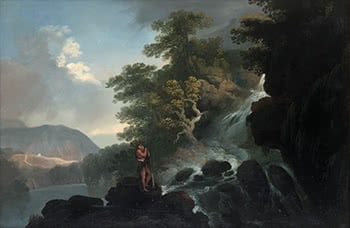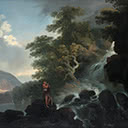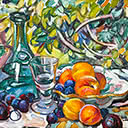A Maori Before a Waterfall in Dusky Bay, 1777
30.5 x 45.7 cm
est. $800,000 - 1,200,000
Click here to view further mages of this Lot on bidding platform
PROVENANCE London, Holzapfel Collection Hamburg, Auktionhaus Stahl, 28 September 2013, lot 378
LITERATURE On Monday 12th April, 1773, a fortnight after his arrival in Tamatea Dusky Sound, Captain James Cook recorded in his journal,
"Being a fine afternoon I took Mr. Hodges to a large Cascade which falls down a high mountain on the South side of the Bay about a League higher up than the Cove where we are anchrd (sic). He took a drawing of it on Paper and afterwards painted it in oyle (sic) Colours which exhibits at one view a better description of it than I can give, ...1"
While the drawing that Hodges made on the spot at Cascade Cove has not survived, there are three known oil paintings of the subject painted by Hodges upon his return to England. One is the large oil on canvas, Cascade Cove, Dusky Bay, signed and dated 'Hodges 75', now in the National Maritime Museum at Greenwich. The second is the small oil on panel, possibly done as a preliminary sketch for the larger oil painting, entitled A Maori before a Waterfall in Dusky Bay, that is now in the collection of the Southland Museum and Art Gallery Niho o Te Taniwha, Invercargill. The third is the oil painting on a metal support offered here. Of this group, the Southland version is most closely related to our picture. It is almost identical in size, viewpoint and composition.
This has led to the assumption, first made by Joppien and Smith and repeated by others, that our painting is a copy of the Southland picture, made by another artist or by some mechanical means.2 However, a close comparison of the two works shows that there are several significant differences, which argue for our painting being a replica painted by Hodges and not a copy made by another artist. For example, the standing Maori figure in our painting has a white whale-bone or albatross feather ear ornament which is absent in the Southland panel. The trunk of the tree emerging from the frothing water is much more clearly defined, as is the clearing in the background on the left with a stream and what appears to be a tent - perhaps a reference to the one erected by the astronomer William Wales at Pickersgill Harbour where the Resolution anchored on arrival in Dusky Sound.
That our painting is by Hodges's hand is also supported by the sheer quality of the paint application. The treatment of the water cascading down through the rocks and the delicately rendered trees is entirely consistent with Hodges' technique. Our view is supported by the leading scholar of the works of William Hodges, Professor Geoff Quilley, formerly curator at the National Maritime Museum, Greenwich and organiser of the exhibition on William Hodges held there in 2004.3 William Hodges was the first professionally trained artist to depict New Zealand subjects in the medium of oil painting. He was appointed the official draughtsman for Cook's second voyage to the Pacific in 1772. During the three-year long voyage Hodges produced dozens of drawings of the places and peoples he encountered. On his return to England in 1775, he was charged with supplying the drawings and paintings to be engraved as illustrations for the official published account of the voyage - a task which occupied him for a further two years. He also worked on large-scale oil paintings for the Admiralty based on the drawings he had done during the voyage.
The paintings that Hodges made from the drawings he had done in the deep south of New Zealand hold a special place in his work. The Resolution reached the safe haven of Tamatea Dusky Sound after three months charting sub-Antarctic waters in the vain hope of discovering their limits. The abundance of fresh water, plentiful seafood and wild game, and the comparative calm of Tamatea must have appeared as a paradise after the long months at sea. Hodges' paintings of Dusky Sound convey something of this view.
The lush vegetation and cascading fresh water provides a setting in which local Maori are portrayed as at one with nature. The encounters between Cook's crew and the indigenous inhabitants were peaceful and cordial. Georg Forster recounts that the members of a Maori family were happy to allow Hodges to draw them and even conferred the epithet of 'tóä tóä' or tuhituhi on him to acknowledge his practice of mark making.4
So, for many reasons, this sale of the only authentic Hodges painting of Cascade Cove still in private hands, is an opportunity to acquire a rare and significant work of great historical importance. The discerning collector who is serious about assembling a collection that tells the history of painting in this country, will recognise the importance of this work as marking the very beginnings of oil painting in New Zealand.
DAVID MASKILL
1 J.C. Beaglehole (ed.), The Journals of Captain James Cook, II The Voyage of the Resolution and Adventure, Cambridge: Cambridge University Press, 1961, p. 119.
2 see Joppien and Smith in literature section above. Barbara Fogarty, the expert on mechanical paintings, has examined the work and concludes that it is not a mechanical painting or polygraph. Fogarty's report is available on request.
3 Geoff Quilley and John Bonehill (ed.), William Hodges 1744-1797: The Art of Exploration, New Haven and London: Yale University
Press, 2004. Dr. Quilley's view that the painting is an authentic work by Hodges' hand was based on his having viewed the painting in London in 2015. Quilley also attested to the existence of other paintings by Hodges on metal supports.
4 Georg Forster, A voyage round the world, in His Britannic Majesty's sloop, Resolution, commanded by Capt. James Cook, during the years 1772, 3, 4 and 5, London, 1777, vol. 1, p. 138.
ILLUSTRATED p. 64 - 65 p. 149, cat. 2.26 The Art of Captain Cook's Voyages, Volume Two, The Voyage of the Resolution and the Adventure 1772 - 1775, Rüdiger. Joppien and Bernard Smith, Melbourne: Oxford University Press, 1985
p. 307, note 43 William Hodges, Cook's Painter in the South Pacific, Laurence Simmons, Tuituhi, Dunedin: Otago University Press 2011





